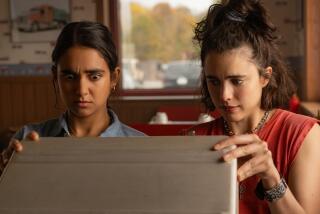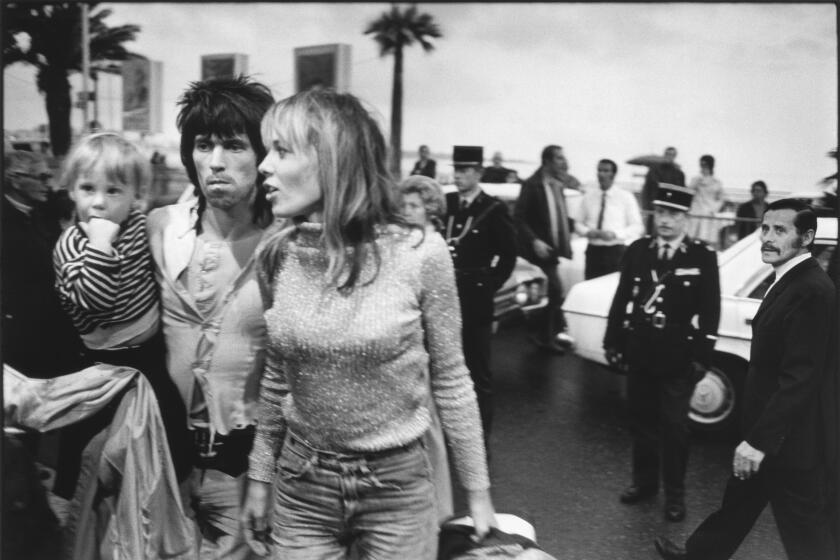Review: ‘Not Fade Away’ grooves on ‘60s in coming-of-age drama
It’s with David Chase’s much-honored individualism in mind that one should best approach — and best enjoy — his first feature film as a writer-director, the wonderfully immersive and evocative “Not Fade Away.” Despite the nostalgia-drenched idealism coursing through it — and a cinematic familiarity to the subject matter — this is not a story that’s neatly told or safely predictable.
The result, though, proves a warmly reflective, diligently crafted and confidently digressive flashback to a time, a place and people Chase, the creator of “The Sopranos,” knows like the back of his hand (as it’s largely drawn from the filmmaker’s own coming of age). “Not Fade Away” is a stirring snapshot of America from 1963 to 1968 and the many rock ‘n’ roll thrills, cultural and political watersheds, and whirling emotions that erupted in between.
It’s also deviously smart and darkly funny.
Chase’s proxy here is Douglas Damiano (John Magaro), a low-key New Jersey teen whose drum-playing with a local garage band, formed during the heady advent of the Beatles and the Rolling Stones, supersedes his academic ambitions, much to the chagrin of his old-school dad (James Gandolfini) and sad-sack mother (Molly Price). The couple’s apoplectic reaction when college freshman Doug returns for Thanksgiving break in de rigueur grown-out hair, peacoat and Cuban-heel boots is priceless.
That not-so-welcome home foreshadows things to come as Doug, looking increasingly like he just jumped off a Bob Dylan album cover, will eventually leave school to pursue his rock ‘n’ roll dreams — locally, that is. This means juggling the conflicting creative agendas and cloudy impulses of his fellow band members, including the self-important Gene (Jack Huston) and the navel-gazing Wells (Will Brill). But with Doug’s soulful vocals usurping longtime friend Gene’s frontman status and Wells so clearly out for No. 1, any lasting unity is elusive.
Then there’s the comely Grace (Bella Heathcote), a daughter of conservative country clubbers and sister to erratic artist Joy (Dominique McElligott), who turns on to the long-smitten Doug once he reveals his singing chops (if that sounds clichéd, it doesn’t play that way). Grace is the pre-hippie dream girl: accessibly gorgeous, pseudo-deep and slyly adventurous. She’s also a next-big-thing kinda gal, which Doug is all too aware of.
Best of 2012: Movies | TV | Pop music | Jazz
The story zigzags through these rebellious years, keeping us fully invested in Doug’s personal and artistic journey as life presents him —and those around him — with various setbacks and possibilities. Suffice to say, the musician and film buff ends up where he belongs, while at the same time closing an important circle.
Chase and his collaborators get the period details here painstakingly right, never falling into kitsch or excess. From the TV and film clips, vehicles and furnishings to the fashions, language and attitudes (not to mention a “Mad Men”-worthy amount of cigarette smoking), viewers who were around in the ‘60s — or just groove on the era — should revel in the wall-to-wall bits of authenticity.
Music, however, is the boss here, and it infuses the picture’s every nook and cranny in vivid, intoxicating ways. Starting with a clever segue from an old Emergency Broadcast System signal into the strangely congruent opening riff of the Stones’ “Satisfaction,” this is a film that knows a great song’s power to move and inspire (no shock considering Chase’s savvy way with music on “The Sopranos”).
Doug’s band gigs (the actors do their own swell performing) are vibrant and fun, covering hits of the day as well as a foray into original tunes (Steve Van Zandt — the film’s music supervisor and executive producer, not to mention a “Sopranos” actor and E Street Band mainstay — wrote the memorable “St. Valentine’s Day Massacre,” well-utilized here in a first-rate band audition scene).
The jammed and jamming soundtrack contains an inventively eclectic mix of rock, pop and blues, with the film’s use of the Rascals’ “I Ain’t Gonna Eat Out My Heart,” the surf-rock instrumental “Pipeline” and, perhaps most unexpectedly, “Bali Ha’i” from “South Pacific” among the many musical highlights.
Best of 2012: Video Games | Art | Theater | Awesome
Chase’s finely chosen cast is uniformly spot-on with Magaro, in his first major lead, deftly carrying the film with an appealing combo of hangdog hotness and unfussy self-possession.
As for Gandolfini, he brings a touch of the old Tony Soprano temper to his blue-collar Pat, but otherwise cuts an enormously affecting figure; a man who rails against — but is clearly envious of — his young son’s burgeoning free spirit. Pat’s restaurant-set confessional to Doug is a heartbreaking seesaw of wistful candor and reflexive armor.
Oscar, take notice.
PHOTOS AND MORE
VIDEO: The making of ‘Argo,’ ‘Les Miz’ and more
The Envelope: Awards Insider
PHOTOS: NC-17 movies: Ratings explained
More to Read
Only good movies
Get the Indie Focus newsletter, Mark Olsen's weekly guide to the world of cinema.
You may occasionally receive promotional content from the Los Angeles Times.






